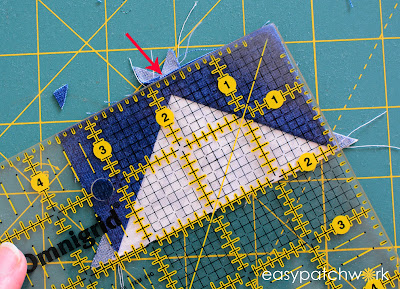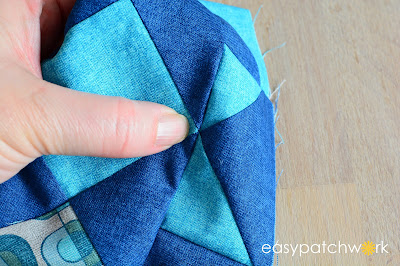Once again, I would like to thank each and everyone of you for reading my blog posts and participating in the quilt along. I am very honored! Thank you!
Here is a reminder of previous posts if you missed one.
Intro
Material and Fabric Requirements (March 1)
Preparation and Cutting Instructions (March 15)
Center Mosaic Medallion (March 29)
Border One (April 12)
Mosaic Blocks (April 26)
Record Blocks (May 10)
Finishing (May 26)
Preparation & Reminders
Please read through the instructions before you begin. You should have knowledge of sewing as well as how to use templates to complete this quilt.- Use high quality patchwork/quilting fabrics and thread for longer endurance.
- All dimensions are given in inches.
- Use a scant 1/4" seam allowance for all seams unless otherwise given.
- Finger press as you go. Press with a warm iron to set your seams. Do not use steam to set seams.
- Use a 2.0 stitch length for smaller blocks. Use a 2.0 - 2.5 stitch length for larger blocks.
- Clip off dog ears as you sew.
Copyright
All designs and templates are protected under copyright laws and may not be photocopied, dublicated or reproduced in any form other than the orginal purchaser for personal, private use. No commercial use of any kind is granted without the written consent from Karen Ackva or easypatchwork. May not be used as teaching material nor used in sellable items. All designs © Karen Ackva - easypatchwork.Mosaic Jig Blocks and Quads
Now that the holidays are over, it is time to get geared back up! The next assigment is going to be a doozy. It is an advanced to expert level. We are going to be sewing on a smaller scale which makes it all a bit harder. It is very crucial that you sew with a precise and accurate 1/4" seam allowance. Since all of the seams in this quilt are pressed to one side or another, that means you will be actually sewing with a scant 1/4" seam allowance. When you fold your seam over to one direction, it carries a bit of the bulk of the seam with it, hence the need for a scant seam allowance.I would highly recommend that you sew three pieces of one inch fabric together and see if it has a precise 2" width. If not, you need to tweek your seam allowance. You can do this by adjusting your needle position or making a washi tape guard to know how far to push your fabric over on the thread plate. This will save you a lot of headaches later. : )
You can read the below blog post for in-depth photo explanations and download the PDF with pattern-like illustrations on my website.
The Mosaic Jig blocks are separated into two different types. There is a single block and there is a row of four blocks, a quad. I decided to make the row of four blocks for two reasons. (1) It reduces the number of patches you need for each block. It also helps to control the seam allowances (due to the lack of seams). (2) It will be more precise in the end when sewing the entire quilt together. This block has a set width of 24", so you won't be able to "square it up" per se. The blocks will be sewn in diagonal and/or horizontal rows.
Before you begin, take a moment to relax. These blocks can be quite challenging. You have time to make them, so don't rush the process. Also, if you wish to press the seam allowances open, then do so. It would be helpful to reduce your stitch to 2,0 on your sewing machine before you start.
Here is what you need to make all of the Mosaic Jig Blocks & Quad Blocks.
Total Number of Patches
| ||||||||
Shape
|
Patch
|
Dimension in Inches
|
Subcut
|
Accent
|
Main
|
Med 1
|
Med 2
|
BG
|
Triangles
|
I
|
4 ¼ x 4 ¼
|
(4) QST
|
84
|
32
|
24
| ||
J
|
2 ⅜ x 2 ⅜
|
(2) HST
|
92
|
20
| ||||
Squares
|
M
|
2 ⅝ x 2 ⅝
|
12
|
10
|
10
| |||
N
|
2 x 2
|
20
| ||||||
Rectangles
|
O
|
2 x 3 ½
|
20
| |||||
Let us begin with the individual blocks first. If you downloaded the Mosaic Jig Block Diagonal Construction Tutorial, then you know how these blocks will be constructed. Don't worry, if you didn't, it is all explained in the downloadable PDF in the link above. Press in the direction of the arrows for best pressed appearance.
Please keep in mind, you will need to make two blocks using each colorway (two with medium 1 & medium 2).
My biggest tip here is to measure the first square segment you sew. It must measure 2 3/8"x 2 3/8". If it does not, square it to that size and/or make adjustments to your seam allowance.
You can even see with the corner square when (N) is attached, whether or not the measurement is correct. Did you know you can write on your rulers with a non-permanent marker? It is great for marking locations.
After you complete your block, square it up leaving 1/4" all the way around your block. Match up other points on the ruler. My goodness, that block looks tiny to me!
After making two Mosaic blocks in each colorway (for a total of four blocks), you can jump on over to the quad blocks. They will be a little more difficult, so you might even want to stop here and do those blocks later.
I find it easiest to lay out all of the pieces for one row to see what is going on and if the patches are in the right places.
This block is assembled the same way as the center medallion only a little bit longer in the width. : )
Make your Flying Geese units and trim them up. Use the 1 3/4" and 3 1/2" marks on the ruler to guide with your trimming. Square up two adjacent sides one right after another without moving the ruler. This ensures your block is square and reduces the amount of block turning. I am also right handed, so I would trim the right side and then the top of the block without turning anything.
Keep sewing a few patches and then put them back in the correct location until you know what goes where.
Most all of your sews will nest. Make to sure measure the width of the rows. Tjhey all should measure 24 1/2" (unfinished).
You might even call me anal on this one, but I trim the width of the rows as well. It is very important you retain the 1/4" above the points. This is more importantant than the overall width of the row.
Pin at all of the intersections and place a pin in the bias triangle areas as well. I try to put the stips and patches ont he bottom that have the least amount of seams. I also like it when I sew over and flatten the seam allowance rather than bringin the seam allowance up (sewing against the seam). Most patterns are written this way.
If you discover the points have too much space left, just sew over the seams again a little bit closer to the points. Don't be afraid to pick out the seams if you sew over one. On this segment, you will want a lot of free space above the points, because it will be pressed inwards.
Open up the two sewn strips to check your points. This is a very good match. The middle row should have about 1/16 free of the other point.
This is a BAD SEAM. Time to get out that favorite seam ripper. You simply must have one for every occasion and in every color. It makes life more interesting. : )
Make sure you alternate the starting fabric square on each of the quad blocks.
And, when you finish, you should get something like this. Do you know how those other Mosaic Jig blocks are supposed to go into the quilt? Is there anther surprise to come? Hmmm.
We would love to see your Mosaic Jig Medallion Quilt. Would you like to share with us too? Please use the hashtag #mosaicjigqal or #mosaicjigblocks for this biweekly assignment on Instagram. If you are sewing along and don't have access to Instragram, send us an photo and we will post for you. Thanks for joining us today.
Oh, I almost forgot. Here's a little sneak peek of what is yet to come. : )





























